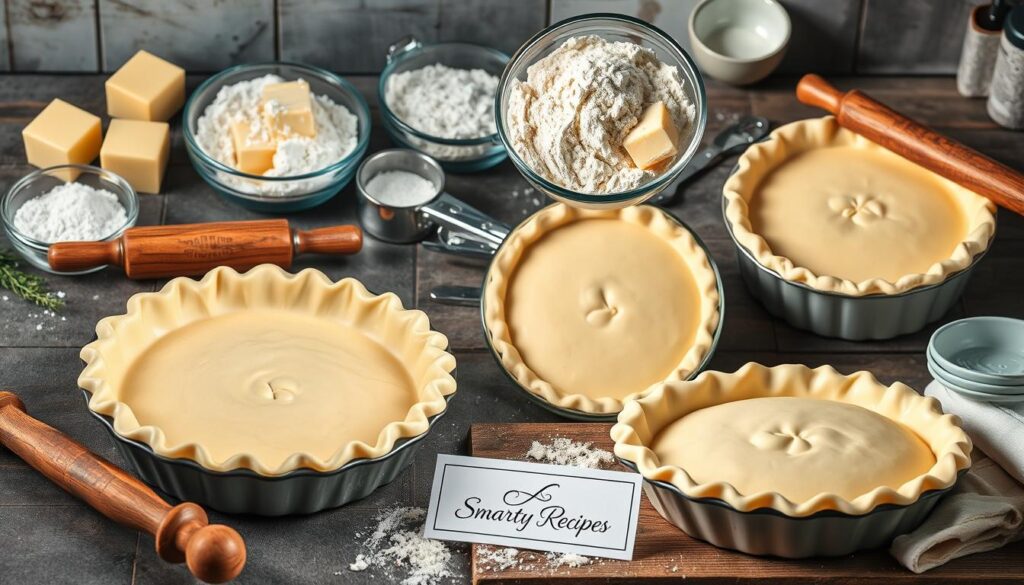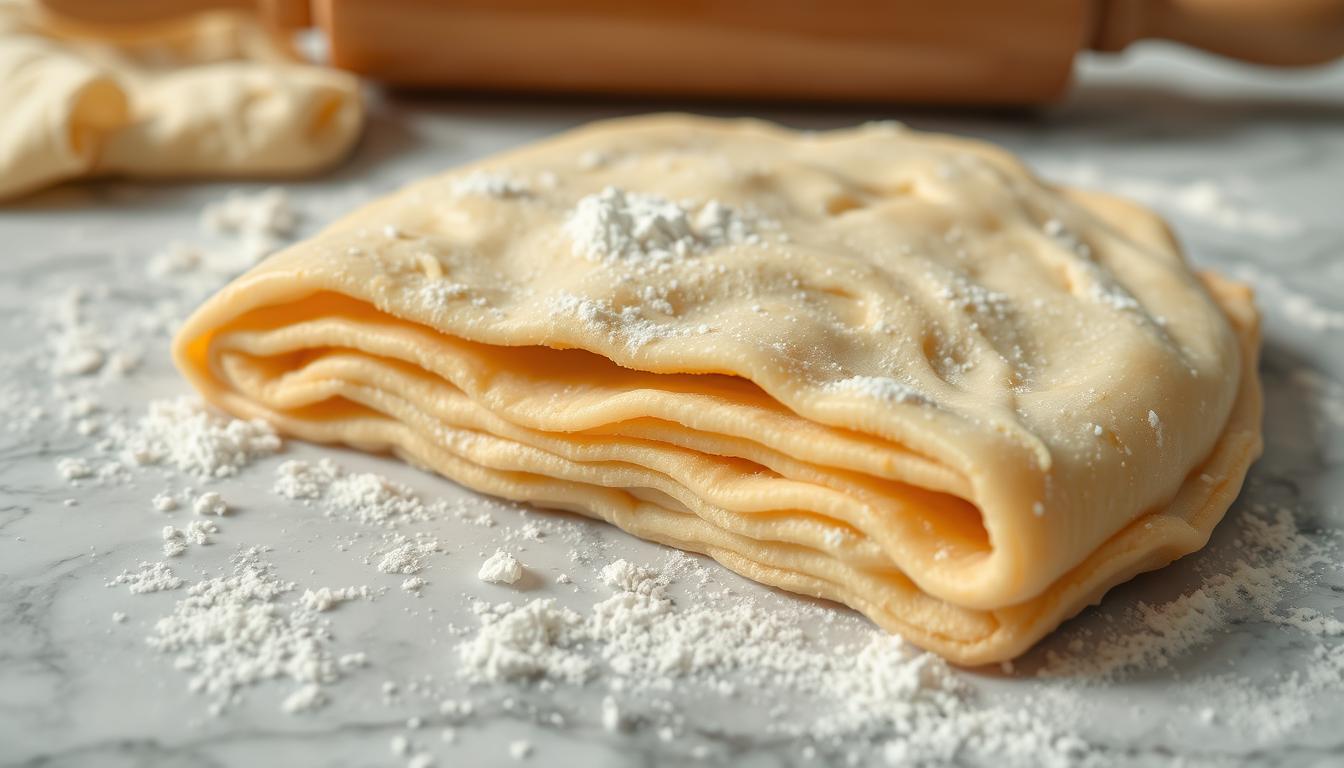There’s something magical about making your own pie crust. It’s the base that makes your favorite desserts special. Imagine the joy and warmth of family gatherings in every bite of that golden, flaky crust.
A buttery flaky pie crust makes any pie extraordinary. It fills your home with inviting smells. With the right recipe, you’ll make more than just pies. You’ll create moments to share with your loved ones.
This guide will show you how to make a crust that’s both delicious on its own and perfect with fillings. It’s a journey into the world of pie dough that will make your heart happy.
Key Takeaways
- A perfect pie crust enhances any dessert experience.
- Understanding the role of ingredients is crucial for achieving flakiness.
- Homemade pie crusts are more delicious than store-bought options.
- Proper techniques can elevate your pie-making skills.
- Chilling dough is essential for a great texture.
- Each pie tells a story, uniting flavors with memories.
Understanding the Basics of Pie Crust
Making a perfect pastry crust can seem hard, but it’s easier once you know the basics. The key to flaky dough is balancing moisture, fat, and mixing methods. Learning about fat in pie dough and different flours helps you make the perfect crust.
What Makes a Pie Crust Flaky?
The size of fat particles in the dough makes the crust flaky. When you mix fat like butter or shortening with flour, it creates pockets. These pockets expand when baking, making the crust light and flaky.
It’s important to handle the dough gently and mix it just enough. This stops the dough from becoming tough. Instead, you get a tender, flaky crust.
The Role of Fat in Pie Dough
Butter, lard, and shortening each add unique tastes and textures to pastry crusts. Butter gives a rich flavor and helps with moisture for flakiness. Lard makes pies tender and is great for savory pies.
Shortening is chosen for its ability to keep the crust tender, even when the temperature changes. Knowing these options lets you customize classic recipes to your taste.
Types of Flour for Pastry Crust
Choosing the right flour is key to a great pie crust. All-purpose flour makes a sturdy crust because of its moderate gluten. Pastry flour is lighter because it has less protein.
For those with dietary restrictions, gluten-free flours like almond or quinoa are available. But they can be harder to work with. The right flour affects the taste and texture of your pie.
Buttery Flaky Pie Crust Recipe

Making the perfect buttery flaky pie crust is all about knowing the key ingredients and tools. This crust is the base for many baking recipes, making your pies taste amazing. Knowing what goes into it helps you get the right texture and flavor.
Essential Ingredients for Success
For a great Buttery Flaky Pie Crust Recipe, you’ll need these ingredients:
- 1 ½ cups all-purpose flour
- ½ teaspoon salt
- 1 stick (½ cup) unsalted butter, chilled and cubed
- 4 to 5 tablespoons ice water
The type of butter you use is crucial for the crust’s taste and flakiness. Choose high-quality unsalted butter for the best flavor. All-purpose flour is key for a tender crust. Ice water keeps the dough cold, preventing toughness during mixing.
Tools You’ll Need for Preparing Dough
Having the right tools is important for making your dough. You’ll need:
- Pastry mixer
- Rolling pin
- Pie dish
- Measuring cups and spoons
- Plastic wrap
- Chill tray for cooling
These tools help mix and roll out the dough right, leading to a perfect crust. With these ingredients and tools, you’re set to make delicious pies that everyone will love.
| Ingredient | Quantity | Role |
|---|---|---|
| All-purpose flour | 1 ½ cups | Base structure |
| Salt | ½ teaspoon | Flavor enhancer |
| Unsalted butter | ½ cup (1 stick) | Flakiness and taste |
| Ice water | 4 to 5 tablespoons | Moisture and temperature control |
Step-by-Step Guide to Making Perfect Pie Dough

Making the perfect Homemade Pie Crust starts with careful preparation and precise techniques. This guide will show you how to make a tender, flaky dough. Every bite will be a delight.
Preparing Your Ingredients
Start by gathering all your ingredients. Use chilled butter, cut into small cubes. Cold butter mixes with flour to create a flaky texture. Measure your flour accurately, choosing all-purpose flour for versatility. Also, have ice water ready to keep the temperature low during mixing.
Mixing Techniques for a Flaky Texture
Use effective mixing techniques to keep the dough flaky. Begin by mixing flour and salt in a large bowl. Then, add the cold butter. Use a pastry cutter or your fingers to cut the fat into the flour. Aim for a mixture that looks like coarse crumbs.
This step is key; don’t overwork the dough. Overworking can lead to a tougher crust.
Chilling the Dough for Optimal Results
After mixing, shape the dough into a disk and wrap it in plastic wrap. Refrigerate it for at least one hour. Chilling the dough lets the fat solidify and the gluten relax. This makes the crust more tender.
Before rolling it out, let it sit at room temperature for five to ten minutes. This makes it easier to handle.
Baking Tips for a Gold-Standard Butter Crust

Getting a perfect Butter Crust takes careful attention during baking. Knowing how to pre-bake and avoiding common mistakes can greatly improve your results. This section shares key tips for baking success.
How to Pre-Bake Your Crust
Pre-baking, or blind baking, keeps your crust intact, especially with custards or fruits inside. Here’s what to do:
- Preheat your oven to 375°F (190°C).
- Roll out the dough and fit it into your pie dish.
- Chill the crust in the refrigerator for at least 30 minutes. This helps prevent shrinking.
- Line the crust with parchment paper or aluminum foil and fill with weights, such as dried beans or pie weights.
- Bake for 15-20 minutes until the edges are lightly golden.
- Remove the weights and parchment, then bake for an additional 8-10 minutes to achieve a golden color.
Avoiding Common Baking Mistakes
Knowing common baking errors can make your baking better. Here are some mistakes to watch out for and how to fix them:
| Mistake | Solution |
|---|---|
| Overworking the dough | Mix until just combined for a flaky texture. |
| Improper oven temperature | Use an oven thermometer to ensure accuracy. |
| Skipping the chilling step | Chill dough before rolling to maintain structure. |
| Not pre-baking when needed | Follow pre-baking guidelines for wet fillings. |
Conclusion
We’ve learned the key to making a Buttery Flaky Pie Crust Recipe. It’s all about understanding flaky dough and using the right baking techniques. Choosing the best ingredients and tools is crucial for that perfect texture and taste in your homemade pie crust.
Now, you’re ready to try different fillings in your pies. Whether it’s a classic apple or a new chocolate cream, each pie lets you show off your cooking skills. Showing off your homemade pie crust makes your dessert look and taste amazing, adding a personal touch to any event.
This holiday season, make pie with confidence and excitement. You know you can make delicious, flaky dough. With time, you’ll impress your friends and family with your pies. A perfect buttery flaky pie crust makes any dessert even better.
FAQ
What makes a buttery flaky pie crust?
A buttery flaky pie crust comes from the right mix of fat, flour, and water. Cold butter, cut into the flour, creates pockets of fat. Chilling the dough makes the fat solid, leading to a tender, flaky texture when baked.
Can I substitute different types of fat in my pie dough?
Yes, you can swap out different fats in your pie dough. Butter is classic, but lard and shortening work too. Lard makes a crust flakier, while shortening makes it tender. Remember, the taste will change with the fat you use.
What type of flour should I use for a pastry crust?
Use all-purpose flour for a pastry crust, or try pastry flour for a lighter texture. Aim for low gluten formation to avoid a tough crust. Bread flour has too much gluten, making the crust hard.
How do I know when my pie crust is perfectly baked?
A perfect pie crust is golden brown, crisp, and slightly firm. Pre-baked crusts should be light tan. With filling, the crust should be brown but not burnt.
What are common mistakes to avoid when baking a pie crust?
Avoid overworking the dough to prevent toughness. Don’t skip chilling the dough, or it won’t be flaky. Baking in a preheated oven helps avoid sogginess, so check your oven’s temperature.
How can I prevent a soggy bottom in my pie?
Blind baking your crust helps prevent a soggy bottom. Pre-bake the crust with pie weights to keep the bottom crispy. This is crucial for custard or fruit pies.
Can I make my pie dough in advance?
Yes! Make your pie dough ahead and keep it in the fridge for three days or freeze for three months. Keep it fresh by wrapping it in plastic or storing it in an airtight container.
What’s the best way to roll out pie dough?
Roll out pie dough on parchment paper or a floured surface. Start from the center and roll outwards. Use even pressure to keep it thin for even baking.

Thanks, this website in useful.